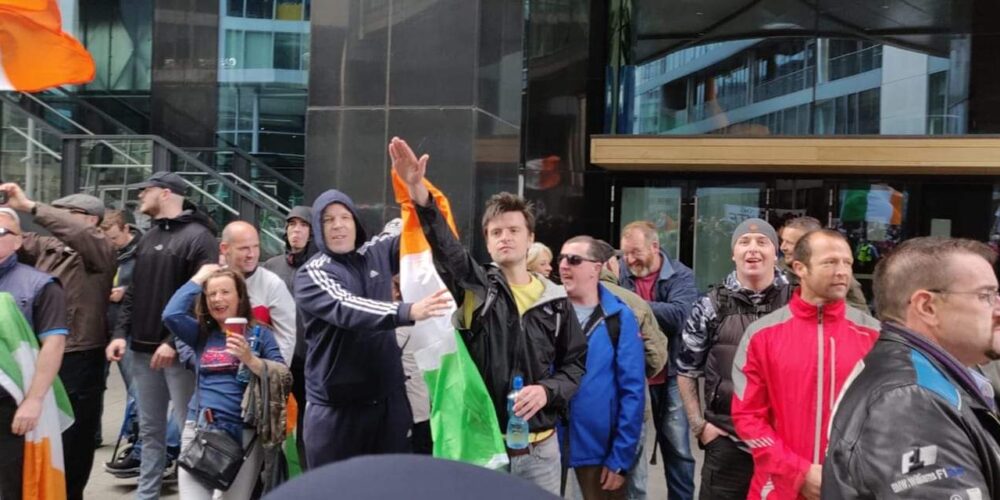What is the nature of those elements now aligned to the anti-immigrant, anti-trans, “nationalistic” and conspiratorial movements seen in Ireland recently? Do such movements mobilise from within particular and consistent segments of the class structure? Are such mobilisations evidence of a risk of far-right elements moving towards mass influence? What level of concern should we have about these groups?
Evidence suggests that such movements comprise some consistent characteristics. Ideologically, they appear prone to irrational, anti-scientific prejudice. Such ideologies associate with base emotions regarding imagined threats to children, women, the dangers of foreigners, etc. There is also a more self-conscious nationalistic element and some cultish religious preoccupations.
Given the available evidence on participants involved in such protests—and such issues as the timing and location of activities—we might infer that they operate on the margins of the labour market—if indeed they are active at all. They are likely to aggregate around low to modest levels of formal education, given evident susceptibility to Facebook-style conspiracies.
How would Marxists conceptualise this grouping? Would such elements come under what Marx and Engels call the lumpenproletariat? If so, Marx and Engels were scathing of this group, categorising them in terms that many might find unpalatable. In the Communist Manifesto this social element is described as “the dangerous class, the social scum, that passively rotting mass thrown off by the lowest layers of old society.” Engels, in The Peasant War in Germany, describes them as “this scum of the decaying elements of all classes, which establishes headquarters in all the big cities.”
Marx, in The Class Struggles in France, refers to them as “a mass sharply differentiated from the industrial proletariat, a recruiting ground for thieves and criminals of all kinds living on the crumbs of society, people without a definite trade, vagabonds . . . varying according to the degree of civilisation of the nation to which they belong . . .” He later elaborates on the make-up of such groupings as incorporating “vagabonds,” “gamblers,” “pickpockets,” “beggars,” “discharged jailbirds”—in sum, “the whole indefinite, disintegrated mass, thrown hither and thither.”
It seems such social elements are treated as different from “honest” elements of the reserve army. Lumpen elements have a non-relation to economic production, sitting outside capitalist relations of production.
Politically, the lumpenproletariat were not only not involved in political actions with their “rightful brethren,” the proletariat: they were prone to be “bribed tools of reactionary intrigue.” Thus in Paris in 1848 Marx writes how Bonapartist forces mobilised lumpen elements to crush the proletarian movements in the June Days Uprising. Donald Trump draws on similar elements today: the “Trumpenproletariat.”
Should the lumpen categorisation apply to those elements active in the Irish movements discussed above? Is this grouping a serious threat? Although this movement is dangerous in the physical and emotional threats it presents to its individual targets and selected groups, if the suggested Marxist categorisation above is correct they are also structurally powerless and politically insignificant, only of serious social threat where mobilised by other class forces for ulterior objectives.
There is no evidence that elements within the Irish ruling classes—a culturally sophisticated milieu that disowns “street politics” of any shade—have any political need for this grouping. Nor is there any compelling evidence that far-right views are permeating into the ideology of the working class; scientific evidence suggests the reverse.*
Nonetheless, one should not be complacent. These groups present real threats to their imaginary enemies. However, their collective societal threat at a sustained political level seems marginal and is likely to burn out or operate at the societal fringe (as is the case with most self-organised activist movements).
Perhaps if such groupings have a base within elements of the atomised modern working class, rather than exclusively lumpen segments, their influence could be of greater cultural magnitude in disseminating reactionary attitudes among some elements of the population. We should not over-inflate the threat of these micro-groupings, but neither should we entirely ignore them.
- Department of Children, Equality, Disability, Integration and Youth, “New survey examines people’s attitudes to diversity in Ireland” (https://tinyurl.com/8v4ap89d).






